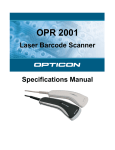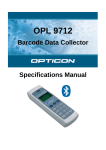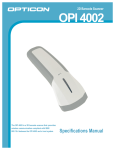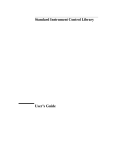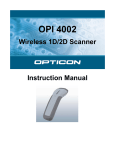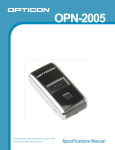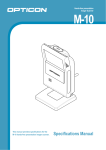Download Opticon OPR 3001 Scanner User Manual
Transcript
OPR 3001 Rugged Handheld Laser Scanner Specifications Manual Opticon OPR 3001 Specifications Manual All information subject to change without notice. Document History Model Number: OPR 3001 Specification Number: SS06106 Edition: 2 Original Spec Number: SS06080 Date: 2006-12-27 Copyright 2007 Opticon. All rights reserved. This manual may not, in whole or in part, be copied, photocopied, reproduced, translated or converted to any electronic or machine readable form without prior written consent of Opticon. Limited Warranty and Disclaimers PLEASE READ THIS MANUAL CAREFULLY BEFORE INSTALLING OR USING THE PRODUCT. Serial Number A serial number appears on all Opticon products. This official registration number is directly related to the device purchased. Do not remove the serial number from your Opticon device. Removing the serial number voids the warranty. Warranty Unless otherwise agreed in a written contract, all Opticon products are warranted against defects in materials and workmanship for two years after purchase. Opticon will repair or, at its option, replace products that are defective in materials or workmanship with proper use during the warranty period. Opticon is not liable for damages caused by modifications made by a customer. In such cases, standard repair charges will apply. If a product is returned under warranty and no defect is found, standard repair charges will apply. Opticon Inc. assumes no liability for any direct, indirect, consequential or incidental damages arising out of use or inability to use both the hardware and software, even if Opticon has been informed about the possibility of such damages. Packaging The packing materials are recyclable. We recommend that you save all packing material to use should you need to transport your scanner or send it for service. Damage caused by improper packaging during shipment is not covered by the warranty. Trademarks Trademarks used are the property of their respective owners. Opticon Inc. and Opticon Sensors Europe B.V. are wholly owned subsidiaries of OPTOELECTRONICS Co., Ltd., 5-3, Tsukagoshi 5-chome, Warabi-shi, Saitama, Japan 335-0002. TEL +81-(0) 48-446-1183; FAX +81-(0) 48-446-1180 SUPPORT USA Europe Phone: 800-636-0090 Email: [email protected] Email: [email protected] Web: www.opticonusa.com Web: www.opticon.com 2 Opticon OPR 3001 Specifications Manual Contents 1. Abstract.................................................................................................................................... 6 2. Overview .................................................................................................................................. 6 3. Physical Features.................................................................................................................... 7 3.1. Dimensions ...................................................................................................................... 7 3.2. Weight.............................................................................................................................. 7 4. Environmental Specifications ................................................................................................ 7 4.1. Operating Temperature and Humidity.............................................................................. 7 4.2. Storage Temperature and Humidity................................................................................. 7 4.3. Ambient Light Immunity ................................................................................................... 7 5. Electrical Specifications ......................................................................................................... 8 5.1. Electrical Characteristics.................................................................................................. 8 6. Optical Specifications............................................................................................................. 9 6.1. Laser Scanning Specification........................................................................................... 9 6.2. Laser Scanning Standard ................................................................................................ 9 6.2.1. Laser Scanning Tilt .................................................................................................................. 9 6.2.2. Scanning Curvature ................................................................................................................. 9 7. Technical Specifications ...................................................................................................... 10 7.1. Print Contrast Signal (PCS) ........................................................................................... 10 7.2. Scan Area and Resolution ............................................................................................. 11 7.3. Pitch, Skew, and Tilt ...................................................................................................... 12 7.3.1. Pitch Angle ............................................................................................................................. 12 7.3.2. Skew Angle and Dead Zone .................................................................................................. 13 7.3.3. Tilt Angle ................................................................................................................................ 14 7.4. Curvature ....................................................................................................................... 15 8. Interface Specifications ........................................................................................................ 16 8.1. RS-232C Interface Specification.................................................................................... 16 8.1.1. Settings and Communication ................................................................................................. 16 8.1.2. Signal Level............................................................................................................................ 16 8.1.3. Interface Circuit...................................................................................................................... 17 8.1.4. Character Format................................................................................................................... 17 8.1.5. Communication Format.......................................................................................................... 18 8.1.6. Handshaking .......................................................................................................................... 18 8.2. USB Interface Specification ........................................................................................... 23 3 Opticon OPR 3001 Specifications Manual 8.2.1. Settings and Communication ................................................................................................. 23 8.2.2. Interface Circuit...................................................................................................................... 23 8.3. Wedge Interface Specification ....................................................................................... 23 8.3.1. Settings and Communication ................................................................................................. 23 9. Cable and Connector ............................................................................................................24 9.1. Cable Specifications ...................................................................................................... 24 9.1.1. RS-232C Cable...................................................................................................................... 24 9.1.2. USB Cable ............................................................................................................................. 25 9.1.3. Wedge Cable ......................................................................................................................... 26 9.2. Scanner Connector Specification................................................................................... 27 10. Readable Barcodes ............................................................................................................... 27 10.1. Menu Barcodes: Default Settings .................................................................................. 27 10.2. Default Settings 1: Readable Codes.............................................................................. 29 10.3. Default Settings 2: Read Options, Trigger, Buzzer ........................................................ 30 11. Serial Number ........................................................................................................................ 31 12. Packaging Specifications ..................................................................................................... 32 12.1. Individual Packaging Specification................................................................................. 32 12.2. Collective Packaging Specification ................................................................................ 33 13. Durability................................................................................................................................ 34 13.1. Electrical Noise .............................................................................................................. 34 13.2. Static Electricity .............................................................................................................34 13.3. Shock ............................................................................................................................. 35 13.3.1. Product Drop Test.................................................................................................................. 35 13.3.2. Shock: Individual Package Drop Test.................................................................................... 35 13.4. Vibration Strength .......................................................................................................... 35 13.4.1. Vibration (without packaging)................................................................................................. 35 13.4.2. Vibration (individual packaging) ............................................................................................. 35 13.5. Dust and Water Proof .................................................................................................... 35 13.6. Cable Strength ............................................................................................................... 36 13.6.1. Cable Pull Strength ................................................................................................................ 36 13.6.2. Cable Bend Strength.............................................................................................................. 36 14. Reliability ............................................................................................................................... 36 15. Auto Trigger (Option)............................................................................................................ 37 15.1.1. Auto Trigger Settings ............................................................................................................. 38 16. Regulatory Compliance ........................................................................................................ 38 4 Opticon OPR 3001 Specifications Manual 16.1. Laser Safety...................................................................................................................38 16.2. Product Safety ............................................................................................................... 38 16.3. EMC ............................................................................................................................... 38 16.4. RoHS ............................................................................................................................. 38 17. Safety ..................................................................................................................................... 39 17.1. Shock ............................................................................................................................. 39 17.2. Temperature Conditions ................................................................................................ 39 17.3. Foreign Materials ........................................................................................................... 39 17.4. Other .............................................................................................................................. 39 18. Mechanical Drawing.............................................................................................................. 40 Table of Figures Figure 1: Ambient light immunity ................................................................................................. 7 Figure 2: Laser scanning tilt and curvature ................................................................................. 9 Figure 3: Scan area and resolution (in mm) .............................................................................. 11 Figure 4: Pitch ........................................................................................................................... 12 Figure 5: Skew angle and dead zone ........................................................................................ 13 Figure 6: Tilt angle ..................................................................................................................... 14 Figure 7: Curvature.................................................................................................................... 15 Figure 8: Interface circuit ........................................................................................................... 17 Figure 9:Character format (same for both sending and receiving) ............................................ 17 Figure 10: Communication format ............................................................................................. 18 Figure 11: No handshaking........................................................................................................ 18 Figure 12: Busy/Ready communication ..................................................................................... 18 Figure 13: Cannot receive command ........................................................................................ 19 Figure 14: Signal timing............................................................................................................. 19 Figure 15: Modem transmit data................................................................................................ 20 Figure 16: ACK/NAK.................................................................................................................. 21 Figure 17: ACK/NAK—No response.......................................................................................... 22 Figure 18: USB interface circuit................................................................................................. 23 Figure 19: RS-232C cable ......................................................................................................... 24 Figure 20: USB cable ................................................................................................................ 25 Figure 21: Wedge cable............................................................................................................. 26 Figure 22: Serial number diagram ............................................................................................. 31 Figure 23: Individual packaging ................................................................................................. 32 Figure 24: Collective packing..................................................................................................... 33 Figure 25: Product drop test ...................................................................................................... 35 Figure 26: Cable bend strength .................................................................................................36 Figure 27: Auto trigger ............................................................................................................... 37 Figure 28: Mechanical drawing..................................................................................................40 5 Opticon OPR 3001 Specifications Manual 1. Abstract This manual provides specifications for the OPR 3001 handheld laser barcode scanner. 2. Overview The OPR 3001 is a rugged handheld laser barcode scanner with protection against dust and splashing water to ensure reliable operation in harsh environments. The OPR 3001 is enclosed in a rugged housing sealed to IP-54 standards that withstands repeated drops of up to two meters onto concrete. Short-wavelength red laser beams enhance the visibility of scanning lines for easier aiming under adverse lighting conditions. The OPR 3001 is available in USB, RS-232C, and Wedge interfaces. Supported symbologies: • JAN/UPC/EAN/all add-on • Codabar/NW-7, including ABC and CX • Chinese Post Matrix 2 of 5 • Code 39: Normal Code 39 / Full ASCII Code 39 / Italian Pharmaceutical • Code 11 • Code 93 • Code 128: EAN-128 • IATA • Industrial 2of5 • Interleaved 2of5 • ISBN-ISMN-ISSN • Korean Postal Authority code • Matrix 2of5 • MSI/Plessey-UK/Plessey • RSS: RSS-14 (incl. CC-A/B) RSS-Limited (incl. CC-A/B)/ RSS-Expanded (incl. CCA/B) • Composite Codes: UCC/EAN-128 (incl. CC-A/B/C) • S-Code • Telepen • Tri-Optic • PDF417 • MicroPDF417 6 Opticon OPR 3001 Specifications Manual 3. Physical Features 3.1. Dimensions W 68 X D 150 X H 155 mm (except protruding portion) 3.2. Weight 230g max (excluding cable). 4. Environmental Specifications 4.1. Operating Temperature and Humidity Temperature: -10 to +60° C Humidity: 5 to 90% RH 4.2. Storage Temperature and Humidity Temperature: -30 to +70° C Humidity: 5 to 90% RH 4.3. Ambient Light Immunity Decoding performance is guaranteed when the range of illumination on a barcode surface is between zero and the following values: Incandescent light to 4,000 lx Fluorescent light to 4,000 lx Sunlight to 80,000 lx Figure 1: Ambient light immunity 7 Opticon OPR 3001 Specifications Manual Conditions Barcode Sample: OPTOELECTRONICS Test Sample PCS: 0.9 Resolution: 0.25 mm Symbology: 9-digit Code-39 Quiet Zone: 10 mm N/W Ratio: 1:2.5 Distance: 100 mm from the edge of scanner Angle: α = 0° β = 15° γ = 0° Curvature: R=∞ Power supply voltage: 6.0 V Direct light or specular reflection light from a source should be prevented from entering the acceptance area. 5. Electrical Specifications 5.1. Electrical Characteristics Parameter Symbol Power supply voltage Operating current IOP Rush current IPEEK Stand-by current IPRE Min Typ Max Unit Remarks 5.4 6.0 6.6 V RS-232C 4.5 5.0 5.5 V USB and Wedge - 96 130 mA RS-232C when emitting - 90 125 mA USB and Wedge when emitting laser - 400 600 mA RS-232C - 300 500 mA USB and Wedge - 35 60 mA RS-232C - 30 55 mA USB and Wedge Conditions: • Connect 1Ω resistance to a power supply line in series and measure the current by the voltage between both ends of resistance. • Power supply voltage is measured at a connector terminal area. • The current value depends on the host computer to which the device is connected. 8 Opticon OPR 3001 Specifications Manual 6. Optical Specifications 6.1. Laser Scanning Specification Parameter Specification Unit Light-emitting Element Red laser diode - Emission Wavelength 650 ±10 (25° C) nm Light Output 1.0 or less mW Scanning Method Bi-directional scanning - Scanning Speed 100 ±20 scans/s Scan Angle Scan angle: 54 ±5 ° Effective scan angle: 44 (Min) ° 6.2. Laser Scanning Standard 6.2.1. Laser Scanning Tilt Laser scanning tilt is the vertical difference between both ends of a laser scan line. Measure it in the middle of the laser scan line. • Up to 1.2 degrees angle in vertical direction from the scan origin (mirror motor). • Up to 3.1 mm at 150 mm from the scan origin. 6.2.2. Scanning Curvature The maximum difference between the laser scan line and the line between both ends of the laser scan line. Measure it in the middle of the laser scan line. • Up to 1.27 degrees angle in vertical direction from the scan origin (mirror motor). • Up to 3.3 mm at 150 mm from the scan origin. Figure 2: Laser scanning tilt and curvature 9 Opticon OPR 3001 Specifications Manual 7. Technical Specifications The conditions for technical specifications are as follows, unless otherwise specified in each section. Conditions Ambient Temperature and Humidity 21º C/70º F, 60% RH Ambient Light 500 to 900 lx Background Barcode = black Space = white Margin = white Background of label = black Power Supply Voltage 6.0 V (RS-232C) / 5.0 V (USB and Wedge) Decoding Test Approve the performance when decoding is successful in all ten tests. (Decoding is deemed successful when completed in 0.5 second or less.) 7.1. Print Contrast Signal (PCS) 0.45 or higher (over 70% of reflectivity of space and quiet zone). 10 Opticon OPR 3001 Specifications Manual 7.2. Scan Area and Resolution The depth of field is measured from the edge of the scanner. The scanning range is within the circular arc centered on the scan origin. Figure 3: Scan area and resolution (in mm) Resolution Symbology PCS Quiet Zone Digit Decode depth (mm) 1.0 mm CODE-39 0.9 25 mm 1 30 - 590 0.5 mm CODE-39 0.9 18 mm 3 10 - 360 0.25 mm CODE-39 0.9 10 mm 8 10 - 200 0.15 mm CODE-39 0.9 7 mm 10 10 - 90 0.127 mm CODE-39 0.9 5 mm 4 20 - 60 Conditions: Barcode Sample: OPTOELECTRONICS Test Sample N/W Ratio: 1:2.5 Angle: α = 0°, β = 15°, γ = 0° Curvature: R=∞ 11 Opticon OPR 3001 Specifications Manual 7.3. Pitch, Skew, and Tilt α = 35° 35° α = 7.3.1. Pitch Angle α = ±35° Figure 4: Pitch 12 Opticon OPR 3001 Specifications Manual 7.3.2. Skew Angle and Dead Zone Skew angle: β = ±50° (Excluding dead zone) Dead zone: β = ±8° (There are some areas in which decoding fails due to specular reflection) Figure 5: Skew angle and dead zone 13 Opticon OPR 3001 Specifications Manual 20° γ = γ = 20° 7.3.3. Tilt Angle γ = ±20° Figure 6: Tilt angle Conditions Barcode Sample: OPTOELECTRONICS Test Sample Distance: 60 mm from the edge of the scanner Label: Pitch Angle, Skew Angle, Dead Zone PCS = 0.9, Resolution = 0.25 mm, Symbology = 9-digit Code-39, Quiet Zone = 10 mm N/W Ratio = 1:2.5 Tilt Angle PCS = 0.9, Resolution = 0.26 mm, Symbology = 13-digit JAN, Quiet Zone = 10 mm Angle: Pitch Angle: Skew Angle β = +15°, Tilt Angle γ = 0° Tilt Angle: Pitch Angle α = 0°, Skew Angle β = +15° Skew Angle, Dead Zone: Pitch Angle α = 0°, Tilt Angle γ = 0° Curvature: R=∞ 14 Opticon OPR 3001 Specifications Manual 7.4. Curvature With 8-digit JAN/UPC/EAN barcodes, decoding performance is guaranteed when R≥15 mm. With 13-digit JAN/UPC/EAN barcodes, decoding performance is guaranteed when R≥20 mm. Figure 7: Curvature Conditions Barcode Sample: OPTOELECTRONICS Test Sample PCS = 0.9, Resolution = 0.26 mm, Quiet Zone = 10 mm Distance: 60 mm from the edge of the scanner Angle: Skew Angle β = +15° 15 Opticon OPR 3001 Specifications Manual 8. Interface Specifications 8.1. RS-232C Interface Specification 8.1.1. Settings and Communication Reading menu barcodes [ZZ] + [U2] + [ZZ] can set the RS-232C interface default. • Item [U2] setting Baud rate 9600 BPS Start/stop bits 1 bit Data bits 8 bits Parity bits No parity Handshaking No handshake Flow Control Time Out Indefinitely You can change the communication condition using the menu barcode. 8.1.2. Signal Level Signal Name I/O RS-232C Level (V) Mark/OFF Space/ON TxD OUT -5 to -15 +5 to +15 RxD IN -3 to -15 +3 to +15 RTS OUT -5 to -15 +5 to +15 CTS IN -3 to -15 +3 to +15 16 Opticon OPR 3001 Specifications Manual 8.1.3. Interface Circuit Figure 8: Interface circuit 8.1.4. Character Format Figure 9:Character format (same for both sending and receiving) 17 Opticon OPR 3001 Specifications Manual 8.1.5. Communication Format Figure 10: Communication format 8.1.6. Handshaking Select handshaking options using the menu or command listed below. Handshaking Menu/Command No handshake P0 BUSY/READY P1 MODEM P2 ACK/NAK P3 ACK/NAK NO RESPONSE P4 a) No Handshaking The scanner attempts the communication regardless of the state of the host computer. Figure 11: No handshaking b) BUSY/READY The scanner and the host computer notify each other of their state and whether they can receive data with BUSY/READY through an RTS line. They can communicate state to each other through a CTS line when connected as in the following figure. Figure 12: Busy/Ready communication 18 Opticon OPR 3001 Specifications Manual The scanner stays ON (is able to receive data) except during certain parts of the process, such as receiving data (buzzer command execution), transmitting data, and menu processing. The scanner checks the CTS line before transmitting data. When it is ON, the scanner transmits data. When it is OFF, the scanner waits for it to turn ON within a set time. The scanner will abort transmission with an error indication (buzzer) when the CTS line is not ON within a specified period. The Flow Control time-outs are as follows, and the default setting is “indefinitely“ (I0). Flow Control Time Out Menu/Command Indefinitely I0 100 ms I1 200 ms I2 400 ms I3 Figure 13: Cannot receive command CTS, TxD signal timing When the CTS line is turned OFF while sending a TxD signal, the scanner transmits one character and waits. When the RTS signal is turned ON while transmitting a character, the character will be transmitted. Figure 14: Signal timing Note: When using loopback (wire connection) for CTS, RTS line of the scanner in this setting, No handshake is not enabled. 19 Opticon OPR 3001 Specifications Manual c) MODEM The scanner turns CS line ON before transmitting data. Other processes are the same as BUSY/READY. Figure 15: Modem transmit data 20 Opticon OPR 3001 Specifications Manual d) ACK/NAK After data has been transmitted, the scanner expects to receive one of the following responses from the host: • ACK response—Action: The scanner completes transmission with the good-read buzzer and returns to the initial state. • NAC response—Action: The scanner sends the data again and waits for the response from the host. • DC1 response—Action: The scanner returns to waiting for the trigger, if it has a trigger (the initial state). • None response—Action: The scanner sounds the error buzzer and returns to the initial state. ACK/NAK timeout can be set as follows using the menu or commands. ACK/NAK timeout Menu / Command Indefinitely (default) XI4 100 ms XI5 500 ms XI6 1000 ms XI7 Figure 16: ACK/NAK 21 Opticon OPR 3001 Specifications Manual e) ACK/NAK NO RESPONSE When no response from the host is received within the setting time, the scanner assumes an ACK response, and returns to the initial state without the error buzzer. The other actions are the same as ACK/NAK. Figure 17: ACK/NAK—No response 22 Opticon OPR 3001 Specifications Manual 8.2. USB Interface Specification 8.2.1. Settings and Communication Reading menu barcodes [ZZ] + [SU] + [ZZ] can set the USB interface default. The OPR 3001 USB model uses a full-speed USB interface. 8.2.2. Interface Circuit Figure 18: USB interface circuit Do not operate the keyboard while the scanner is transmitting the data to the host; it may cause data transactions to fail. 8.3. Wedge Interface Specification 8.3.1. Settings and Communication a) With desktop PC (using external keyboard) Reading menu barcodes [ZZ] + [UB] + [KM] + [ZZ] can set the DOS/V Wedge interface default. b) With notebook PC (not using external keyboard) Reading menu barcodes [ZZ] + [UB] + [KL] + [ZZ] can set the DOS/V Wedge interface default. Do not operate the keyboard while the scanner is transmitting the data to the host; it may cause data transactions to fail. 23 Opticon OPR 3001 Specifications Manual 9. Cable and Connector 9.1. Cable Specifications 9.1.1. RS-232C Cable (Standard specification) Type: Straight Diameter: Φ4.8 ±0.5 mm Length: 1500 ±50 , -0 mm Cores: 8 insulated wires, 1 conductive wire Weight: Approximately 80 g Figure 19: RS-232C cable a) Pin Assignment Pin No Signal Name Notes 1 NC Open (not assigned) 2 TXD 3 RXD 4 --- 5 GND 6 --- 7 CTS 8 RTS 9 NC Pin no. 6 and jumper Pin no. 4 and jumper Open (not assigned) Connector: A connector with a plug for external power supply (D-sub, 9-pin, female) Power Supply: φ4.0 (inside diameter: φ1.7) Exterior electrode of the plug is GND and interior electrode is +. 24 Opticon OPR 3001 Specifications Manual 9.1.2. USB Cable (Standard specification) Type: Straight Diameter: Φ4.8 ±0.5 mm Length: 1500 ±50, -0 mm Cores: 4 insulated wires, 1 conductive wire Weight: Approximately 60 g Figure 20: USB cable a) Pin Assignment Pin No Signal Name 1 VCC 2 -DATA 3 +DATA 4 GND 25 Opticon OPR 3001 Specifications Manual 9.1.3. Wedge Cable (Standard specification) Type: Y cable Diameter: Φ4.8 ±0.5 mm Length: 1500 ±50 , -0 mm Cores: 8 insulated wires, 1 conductive wire Weight: Approximately 80 g Figure 21: Wedge cable a) Pin Assignment DOS/V Host Side DOS/V Keyboard Side Pin No Signal Name Pin No Signal Name 1 CPU_DATA 1 KEY_DATA 2 --- 2 --- 3 GND 3 GND 4 VCC 4 VCC 5 CPU_CLK 5 KEY_CLK 6 --- 6 --- 26 Opticon OPR 3001 Specifications Manual 9.2. Scanner Connector Specification CN801 (13-pin) Signal Name Pin Number RS-232C USB Wedge 1 NC VCC VCC 2 R×D NC NC 3 T×D NC NC 4 NC NC CPU_CLK 5 NC NC CPU_DATA 6 GND GND GND 7 NC USB+ NC 8 NC USB- NC 9 NC NC KB_DATA 10 NC NC KB_CLK 11 CTS NC NC 12 RTS NC NC 13 VCC NC NC 10. Readable Barcodes 10.1. Menu Barcodes: Default Settings Default menu barcodes set the scanner to factory defaults. RS-232C Default Functions Menu labels Menu codes SET _ZZ_ _U2_ _W1_ _W7_ _S0_ ZZ RS-232C Single tone buzzer: 3 kHz* Buzzer duration: 50 ms* Read mode options: Single read* END U2 W1 W7 S0 _ZZ_ ZZ 27 Opticon OPR 3001 Specifications Manual * If you are using software version TS01Y04 or later, it is not necessary to configure the foregoing settings. USB-HID Default Functions Menu labels Menu codes SET _ZZ_ _SU_ _ZZ_ ZZ USB default END SU ZZ Wedge Default (with external keyboard) Functions Menu labels Menu codes SET _ZZ_ _UB_ _KM_ _ZZ_ ZZ AT Wedge default Keyboard layout: with keyboard END UB KM ZZ Wedge Default (without external keyboard) Functions Menu labels Menu codes SET _ZZ_ _UB_ _KL_ _ZZ_ ZZ AT Wedge default Keyboard layout: without keyboard END UB KL ZZ 28 Opticon OPR 3001 Specifications Manual 10.2. Default Settings 1: Readable Codes Code type Reading Transmit Code Length Transmit CD Calculate CD Prefix Suffix UPC-A X - CR UPC-A Add-on X X - CR UPC-E X - CR UPC-E Add-on X X - CR EAN-13 X - CR EAN-13 Add-on X X - CR EAN-8 X - CR EAN-8 Add-on X X - CR Code-39 X X - CR Not transmit ST/SP Code-39 Trioptic X X - CR Not transmit ST/SP NW-7 (CODABAR) X X - CR Not transmit ST/SP Industrial2of5 X X - CR Interleaved2of5 X X - CR Code-93 X - CR Code-128 X - CR EAN-128 X X - CR S-Code X X - CR MSI/Plessey X CD1 CD1 - CR UK/Plessey X - CR Telepen X X - CR Matrix2of5 X X X - CR Chinese Post Matrix 2of5 X X X - CR IATA X X - CR RSS-14 X X - CR RSS-limited X X - CR RSS-expanded X X - CR PDF417 X X - - - CR MicroPDF417 X X - - - CR Code 11 X X X - CR 29 Transmit Other Opticon OPR 3001 Specifications Manual Notes: • In the “Reading” column, “” means “Enable reading” and “X” means “Disable reading.” • In the “Transmit code length” column, “” means “Transmit code length” and “X” means “Do not transmit code length.” • In the “Transmit CD” column, “” means “Transmit check digit” and “X” means “Do not transmit check digit.” • In the “Calculate CD” column, “” means “Calculate check digit” and “X” means “Do not calculate check digit”. 10.3. Default Settings 2: Read Options, Trigger, Buzzer Item Default Setting Setting the number of characters Fixed length OFF all codes Read mode Multiple read Multiple read reset time 500 ms Add-on wait mode 500 ms Multiple read Disable multiple read Multiple columns read Disable multiple columns read Redundancy Read 1 times, redundancy = 0 Trigger switch Enable trigger Trigger repeat Disable trigger repeat Auto trigger Disable auto trigger Read time 2 seconds Margin check Margin check normal Buzzer duration 50 ms Buzzer tone 3 kHz (single tone) Buzzer loudness Maximum Buzzer timing Buzzer before transmission Startup buzzer Enable startup buzzer Indicator duration 200 ms 30 Opticon OPR 3001 Specifications Manual 11. Serial Number The serial number as shown below is affixed to the scanner. Figure 22: Serial number diagram 31 Opticon OPR 3001 Specifications Manual 12. Packaging Specifications 12.1. Individual Packaging Specification Put the scanner in a protective foam bag and place it in a single packing box. The scanner shown is an RS-232C unit. Descriptions on an individual packaging box label differ, depending on the interface type. The “RO” mark may be indicated on the upper side of the individual packaging box label. Figure 23: Individual packaging 32 Opticon OPR 3001 Specifications Manual 12.2. Collective Packaging Specification The scanner shown is an RS-232C unit. Descriptions on a collective packaging box label differ, depending on the interface type. The “RO” mark may be indicated on the upper side of the individual packaging box label. Figure 24: Collective packing Note: The “RO” mark labeled on the package tray or package box guarantees that the applicable product has passed our test of RoHS restrictions compliance (the restriction of the use of certain hazardous substances in electrical and electronic equipment, 2002/95 EC). However, this document does not have any legal weight in the European Union. 33 Opticon OPR 3001 Specifications Manual 13. Durability 13.1. Electrical Noise No malfunction should occur when sinusoidal electrical noise (10Hz -100kHz, < 0.1Vpp) is added to a power supply line. Conditions Barcode Sample: OPTOELECTRONICS Test Sample PCS: 0.9 Resolution: 0.25 mm Symbology: 9-digit Code-39 Quiet Zone: 10 mm N/W Ratio: 1:2.5 Distance: 100 mm from the edge of scanner Angle: α = 0° β = 15° γ = 0° Curvature: R=∞ Power Supply Voltage: 6.0 V (RS-232C) / 5.0 V (USB and Wedge) 13.2. Static Electricity Air discharge: 8 kV max (No malfunction) 15 kV max (No destruction) Contact discharge: 6 kV Contact discharge at the hook and the screw Measurement environment: Use electrostatic testing device compliant with IEC 61000-4-2 Discharge resistance: 330 Ω Capacitor charging: 150 pF 34 Opticon OPR 3001 Specifications Manual 13.3. Shock 13.3.1. Product Drop Test No malfunction should occur after the following drop test. As shown below, drop the scanner from 200 centimeters above the concrete floor (three times from each of 6 angles). Figure 25: Product drop test 13.3.2. Shock: Individual Package Drop Test No malfunction should occur after the following drop test. Drop the individual package box from 150 centimeters above the concrete floor (ten times from random angles: on its top, bottom, front, back, left, right, top-left, top-right, bottom-left, bottom-right). 13.4. Vibration Strength 13.4.1. Vibration (without packaging) Swept with 10 Hz to 100 Hz, acceleration 19.6 m/s2 (2.0G). Added a vibration to each X, Y and X direction for 30 minutes (1 cycle = 60 minutes) under nonoperational conditions. Observed no abnormality in either appearance or performance. 13.4.2. Vibration (individual packaging) Swept with 10 Hz to 100 Hz, acceleration 19.6 m/s2 (2.0G). Added a vibration to each X, Y and X direction for 30 minutes (1 cycle = 60 minutes) with individual packaging. Observed no abnormality in either appearance or performance. 13.5. Dust and Water Proof IEC IP54 35 Opticon OPR 3001 Specifications Manual 13.6. Cable Strength 13.6.1. Cable Pull Strength Affixed the scanner to an immovable object and pulled it using a force of 49N (5.0 kgf) for 1 minute. Observed no abnormality in either structure or performance. 13.6.2. Cable Bend Strength As shown below, added a load of 4.9N (500 g) to a cable then bent it at an angle of 90 degrees to both right and left. Count 1 time by bending to either side; repeated this 3 million times on RS-232C and Wedge cables and repeated 1 million times on USB cable. Observed no abnormality in either structure or performance. Note: Cable bending resistance is not warrantable. Figure 26: Cable bend strength 14. Reliability MTBF (mean time between failures) of this product except for the laser diode and the mirror motor scan unit is 30,000 hours. Life cycle of the laser diode is 10,000 hours and that of the mirror motor scan unit is also 10,000 hours. The estimate of MTBF and product life cycle is based on standard operation of the product within the recommended temperature range and without extreme electronic or mechanical shock. 36 Opticon OPR 3001 Specifications Manual 15. Auto Trigger (Option) The OPR 3001 has an optional auto trigger setting, which starts barcode reading automatically by using sensor detection. When auto trigger is enabled, a laser beam is emitted and points to the auto trigger area. The scanner starts barcode reading after detecting reflection from the surface when the auto trigger is used. Auto trigger distance: 40 mm from the edge of the scanner. Conditions Moving Speed: 100 ±10 mm/s Angle: Skew angle, excluding pitch angle and dead zone Environmental Temperature and Humidity: Room temperature and humidity Environmental luminance: 500 to 900 lx Conditions for the auto trigger: 1. Barcode sheet: OPTOELECTRONICS Test Sheet (white) Background: OPTOELECTRONICS Test Sheet (black) 2. Barcode sheet: OPTOELECTRONICS Test Sheet (black) Background: OPTOELECTRONICS Test Sheet (white) Figure 27: Auto trigger 37 Opticon OPR 3001 Specifications Manual 15.1.1. Auto Trigger Settings Functions SET Disable auto trigger Enable auto trigger END Menu labels Menu codes _ZZ_ _+F_ _+I_ _ZZ_ ZZ +F +I ZZ 16. Regulatory Compliance 16.1. Laser Safety The scanner emits laser beams. • JIS C6802: 2005: Laser class 1 • IEC 825-1/EN 60825-1: Laser class 1 • FDA CDRH Laser class I. Complies with 21 CFR 1040.10 and 1040.11 except for deviations pursuant to laser notice No. 50 dated July 26, 2001 Class 1 laser devices are not considered to be hazardous when used for their intended purpose. Avoid staring into the laser beam. 16.2. Product Safety EN60950-1: 2001 IEC60950-1: 2001 16.3. EMC EN55022 EN55024 FCC Part15 Subpart B Class B: This device complies with part 15 of FCC rules. Operation is subject to the following two conditions: (1) this device may not cause harmful interference, and (2) this device must accept any interference received, including interference that may cause undesired operation. VCCI Class B: This is a Class B product, to be used in a domestic environment, based on the Technical Requirement of the Voluntary Control Council for Interference from Information Technology Equipment (VCCI). If this is used near a radio or television receiver in a domestic environment, it may cause radio interference. 16.4. RoHS The restriction of the use of certain hazardous substances in electrical and electronic equipment, 2002/95 EC 38 Opticon OPR 3001 Specifications Manual 17. Safety 17.1. Shock • Do not throw or drop the scanner. • Do not place heavy objects on the cables. 17.2. Temperature Conditions • Do not use the scanner at temperatures outside the specified range. • Do not pour boiling water on the scanner. • Do not throw the scanner into the fire. • Do not forcibly bend the cables at low temperatures. 17.3. Foreign Materials • Do not immerse the scanner in liquids. • Do not subject the scanner to chemicals. 17.4. Other • Do not plug/unplug the connectors before disconnecting the power. • Do not disassemble this product. • Do not use the scanner near a radio or a TV receiver. It may cause reception problems. • The scanner may be damaged by voltage drops. • The scanner may not perform properly in environments when placed near a flickering light, such as a computer monitor, television, etc. 39 Opticon OPR 3001 Specifications Manual 18. Mechanical Drawing Dimensions: 3 W 68 X D 150 X H 155 (mm) (except protruding portion) Figure 28: Mechanical drawing 40








































